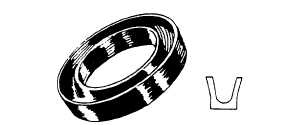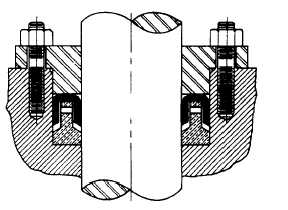U-CUPS AND U-PACKINGS
The distinction between U-cups and
U-packings results from the difference in materials
used in their fabrication. The U-cup is usually
made of homogeneous synthetic rubber;
U-packings are usually made of leather or fabric-
reinforced rubber. Special aspects of each type will
be discussed separately. However, all U-cups and
U-packings have cross sections resembling the
letter U. Both types are balanced packings, both
seal on the ID and the OD, and both are applied
individually, not in stacks like V-rings. Size
differences between U-cups and U-packings are
usually substantial enough to prevent inter-
changeability. There are a few sizes with smaller
diameters and cross sections that may appear
to be dimensionally equivalent but are not.
Therefore, U-packings should not be substituted
for U-cups (or vice versa) in any installation.
U-CUPS
The U-cup (fig. 7-18) has been a popular
packing in the past because of installation ease
and low friction. U-cups are used primarily for
pressures below 1500 psi, but higher pressures are
possible with the use of antiextrusion rings. For
double-acting pistons, two U-cups are installed
in separate grooves, back-to-back or heel-to-heel.
Two U-cups are never used in the same groove.
This heel-to-heel type of installation is common
for single-acting (monodirectional) seals, such as
U-cups and V-rings, and is necessary to prevent
a pressure trap (hydraulic lock) between two
packings. Installation of two U-cups with sealing
lips facing each other can result in hydraulic lock
and must be avoided.
Leather U-Packings
As a rule, leather U-packings are made with
straight side walls (no flared sealing lips). See
figure 7-19. The leather may be chemically treated
or otherwise impregnated to improve its per-
formance. Leather U-packings are available in
standard sizes conforming to industrial specifica-
tions. For support, the cavity of the U-packing
should contain a metal pedestal ring or should be
filled with a suitable material. Leather U-packings
with an integral pedestal support have been
installed in some submarine steering and diving
ram piston seals.
CUP PACKINGS
Cup packings resemble a cup or deep dish with
a hole in the center for mounting (fig. 7-20). Cup
seals are used exclusively to seal pistons in both
low- and high-pressure hydraulic and pneu-
matic service. They are produced in leather,
homogeneous synthetic rubber, and fabric-
reinforced synthetic rubber. Although the cup
packing lip flares outward, the rubbing contact
is made at the lip only when the fluid pressure is
low. As the fluid pressure increases, the cup heel
expands outward until it contacts the cylinder
wall, at which point high-pressure sealing is in
effect. As the pressure loading shifts the sealing
line to the cup heel, the lip is actually pulled into
the cup and away from the cylinder wall. On the
return stroke when the pressure is relaxed, the heel
will shrink slightly, leaving only the lip in contact
with the wall, avoiding unnecessary wear at the
heel.
For reciprocating pistons, two cups installed
back-to-back in separate glands are required.
FLANGE PACKINGS
Flange packings are used exclusively in low-
pressure, outside-packed installations, such as rod
Figure 7-18.—Typical U-cup seal.
Figure 7-19.—U-packing.
7-16




